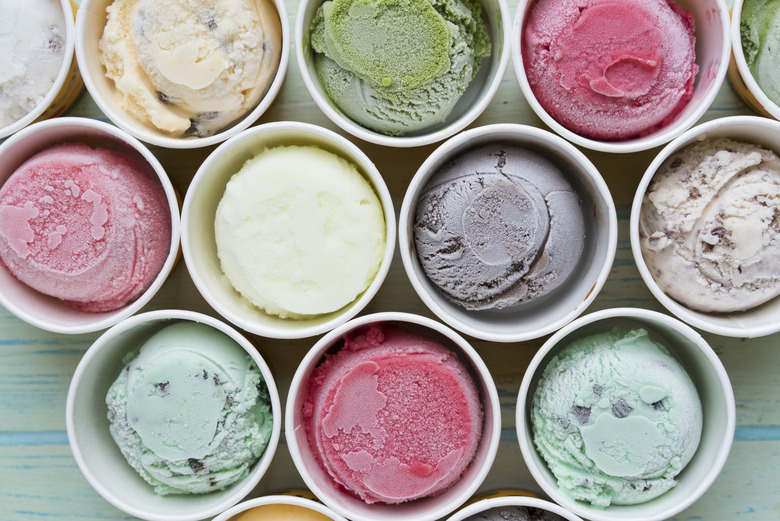Why I Stopped Buying Low-Calorie Ice Cream
A couple of years ago, entering the ice cream aisle was simple. You were bombarded with labels coated in photos of drool-worthy dessert and sweet, sweet temptation — and you didn't base your dessert decision on much beyond price and chocolate versus vanilla.
Now, though, there are a myriad of other factors interfering in your choices. How many calories does this pint have? Should I stop eating dairy? What about sugar? This one has protein!
No longer are simple thoughts like "Ooh! Chocolate chip cookie dough!" followed by a quick toss into your cart. The aisle has smacked you in the face with another, more complicated form of marketing: guilt.
I used to buy into this tactic — I'd opt for the diet-friendly pints and expect satisfaction when I ate each spoonful of watered-down dessert. I was promised salvation in the form of guilt-free indulgence. Sweets without consequences. Indulgence without the risk. Diet ice cream almost sounded too good to be true! But it was a real product!
But when I actually ate the ice cream, my experience was wholly different. At first, I felt righteous in my choice. I sat down in front of the TV, opened the pint, and dug in without hesitation. I didn't get nervous about fats and sugars I was putting into my body. I didn't anxiously review the nutrition facts and serving sizes like I'd been taught to by all the health and diet information I'd read online. What a relief — right? But in real time, it didn't feel that way.
Each bite was seriously unsatisfying compared to a bite of the full-fat, sugary stuff I was used to eating. I finished half the pint and put it away, realizing that I didn't want any more. Also strange was that my craving for dense, milky ice cream hadn't gone away.
Instead of eating a small bowl of sugar, cream, and chocolate (always my choice for a mix-in), I'd consumed a much more voluminous portion of zero-calorie sweeteners, diluted cream, and protein powder. Blech. My stomach wasn't happy with me. And I still craved more sugar.
But I kept on with the trend. I figured I'd adapt — that my taste buds were just "addicted" and conned into thinking they needed sugar and cream to feel satisfied.
More of my grocery budget was going toward dessert than ever before. I found myself thinking about portions and limits on how much of my low-cal ice cream I "could" eat that day; when I bought the normal stuff, I'd just scoop a bit into a bowl whenever I wanted it. I didn't fly through containers of ice cream very quickly at all; it was rarely even on my mind.
Instead of the guilt-free experience I'd been promised, I felt more guilt, became more obsessed, and felt more crazed by my cravings than ever.
As a health writer and fitness instructor, I've spent a lot of time understanding and learning about dieting and psychology. After some contemplation, I think I know what was going on.
First of all, I wasn't actually satisfying my sugar craving with the low-calorie pint. You just can't replace the real stuff. That's why many so-called healthy swaps don't actually work. That's the problem with zoodles. I mean, who has ever felt the same sense of satisfaction after eating zucchini as they have after pasta? It's the same with ice cream.
I was just adding additional foods to my diet that weren't what I really wanted. As a result, I was stuffing my body with additives and fake sugar that were messing with my digestion, making me super thirsty, and left me with an odd aftertaste when I could have just eaten a reasonable amount of sugar and felt fantastic.
But more importantly, every time I "treated myself" to dessert, the fact that I was dieting was on my mind. I was making decisions about food based on fears I had — about putting on weight, about fueling an addiction to sugar, about the weight I could be losing — instead of what my body was telling me it wanted. I was making my appearance more important than my happiness. As a result, I found myself actually feeling more insecure.
That's right: I felt better about my body eating full-fat dessert than I did eating something diet-friendly.
Of course, this is just my experience — but from what I know about nutrition and health, a pint of low-calorie ice cream isn't much better for you than a single serving of the good stuff.
Now that I've switched back to regular ice cream, I'll never go back. Not only do I feel physically better, but I'm also far less preoccupied with cravings, nutrition numbers, and serving sizes. Now, I'm actually guilt-free when I eat dessert. So instead of fretting over the consequences of carbs and calories, you might want to consider the consequences of eating a diet-friendly dessert that promises to satisfy.
Holly Van Hare is the Healthy Eating Editor at The Daily Meal with a passion for podcasting and peanut butter. You can listen to her podcast Nut Butter Radio on iTunes and follower her health food Instagram @eating_peanut_better.
